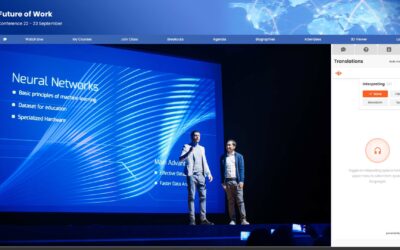How do you measure an event’s success?
What data can (and should) you capture and how can you use this to quantify successful areas of your event? What statistics can you use to identify areas for improvement? These are all big questions! And where’s the best place to start?…
Virtual and Hybrid Events provide opportunities to measure, analyse and improve the user experience which are unparalleled elsewhere. ROI and user experience analytics might sound techy and complicated terms but in reality these analytics are clever and ingenuously simple (that’s the good bit!). When you set up your Virtual Event in the right way you can use these metrics, and results, to make your events best in their class. Let us take a look at how…
ROI and KPI’s
Every finance director loves a statistic – quite rightly. You need to know the money you’ve invested in an event is well spent. But one of the difficult things when you’re creating something, well, creative, is to attach numbers and statistics to it and to make that success quantifiable. Event organisers can feel when an event went well, but it’s important to be able to illustrate this in clear, undeniable black and white facts to other stakeholders too. It might sound complicated and daunting but – this is the fun bit – it’s 100% possible and straightforward. The key is to approach it correctly from the beginning and work out the stats you need before you start designing the event itself.

First step: Get your objectives and KPI’s straight
Define how and why you are running your event and the desired output and outcomes. Once you have these objectives outlined you can decide which KPIs you’ll use to measure them. Your KPI’s will be the things you can measure which illustrate your objectives in a statistical way.
It’s simple really. Here are some examples…
- Educational event: Here you will likely be looking specifically at knowledge or confidence on a content topic, peer to peer networking and test or assessment results. Example KPI’s: Poll results, speaker Q&A’s and results from gamification you build into the event.
- Sales conference: You are likely to want to look at things like new prospects, networking, conversations, customer needs analysis and ultimately conversions and sales revenue. Example KPI’s: New contacts, qualified leads, pipeline figures, orders taken, revenue, and chat Q&A.
- Product launch event: Here you are likely to be looking at user and customer opinions and qualitative feedback. Example KPI’s: Polls, website and social media engagement and Net Promoter Scores. (There are some more great ideas here).
Second step: Work out the KPI’s you’ll need
Here is a list of some great KPI’s that can be used to analyse Virtual Event success. Not all will apply to every event, obviously, you’ll need to make sure the KPI’s for your event are unique to your event and measure your objectives as outlined in point 1. But, here’s a great starter for ten to get you thinking…
- Registration numbers
- Attendance numbers
- Live polls
- Clicks
- % of game zones used
- Types and methods content consumption
- Social media engagement
- Audience Q&A
- Online search traffic
- Breakout attendance
- Exhibition stand interaction
- Revenue generated
- Feedback surveys
- Hot spots
- Chat rooms
- Net promoter scores
- Gamification results (i.e. Leader boards)

Third step: Run your event and collect your data
Once you know what data you need, set up your event to include a dashboard for stakeholders to be able to see that data. This can be done before, during and post event and should be collected and analysed post event. The sky’s your limit and dashboards can be made to suit the requirements of the event and stakeholders.
Fourth and final step? Analyse your results
Once your event has finished and you have collected your data, now is the time not only to measure your results and work out your successes, but also to analyse areas of improvement and change. Those who are best in their class will look at continuous improvement throughout all of their events, and the key? The stats that help you do this…

It’s clear that Virtual Event are fantastic at providing data led insights that can drive much positive change within an organisation, and also be a direct route to customers, staff or other relevant audiences. For more information on how to approach metrics for your Virtual or Hybrid Event, get in touch or read more on our Metrics page. Either way we’d love to hear from you.
Book a time with one of our team to discuss your next project
More insights from the Procreation blog
Procreation and Interprefy partnership
Procreation are delighted to announce their new...
Unmissable features for Virtual Events: Network Café
Virtual Event Feature spotlight - Networking...
Gen Z in the workplace: what you need to know
Gen Z – the next generation of workers Gen Z is...




